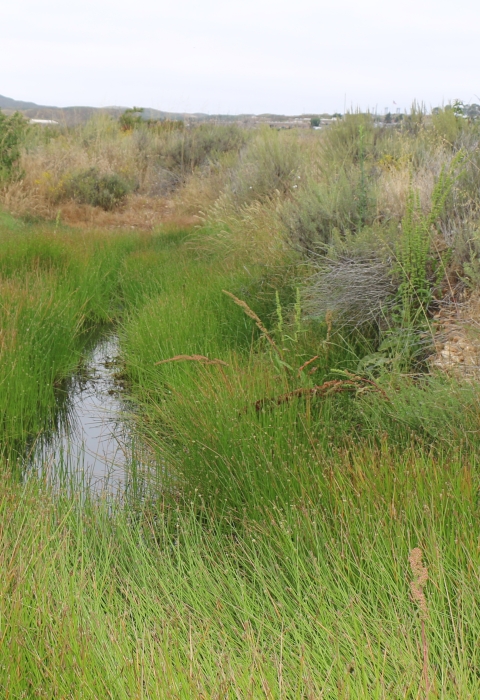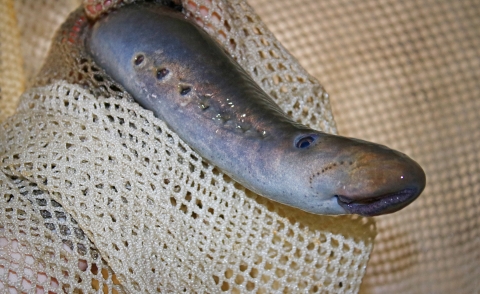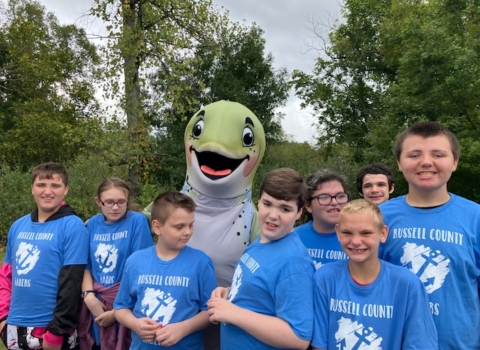On Marine Corps Base Camp Pendleton, there’s a promontory of land that overlooks the expanse of the base, including the Santa Margarita River flowing next to the flightline. In October, a group of U.S. Fish and Wildlife Service employees joined their Marine Corps counterparts on the promontory to present the base with the Service’s 18th Annual Military Conservation Partner of the Year award.
The base was recognized for its commitment to conservation in developing sustainable natural resource management and protection strategies balanced against military training needs. The base’s Environmental Security Department collaborates with the Service, the state of California, and multiple public and private organizations to restore and protect habitat for 19 federally threatened and endangered species that live on the installation.
“Camp Pendleton is a conservation leader and shining example of what can be accomplished for species recovery on military land,” said Paul Souza, Regional Director of the Service’s Pacific Southwest Region. “We are grateful for their dedication and stewardship and look forward to a continued partnership.”
For some in attendance, the ceremony was reminiscent of almost 27 years ago when former U.S. Interior Secretary, Bruce Babbitt, and then commander, Maj. Gen. Claude Reinke, stood on that same promontory celebrating the issuance of the first programmatic biological opinion for the Department of Defense that provided take coverage for federally listed species while addressing current and future training on Camp Pendleton.
The use of Camp Pendleton as a military training installation has prevented large-scale development within a relatively intact area along the Southern California coast, maintaining habitat for an array of rare species.
Its 125,000 acres is a biodiversity hotspot encompassing coastal lagoons and estuaries, coastal dunes, native grasslands, coastal sage scrub, chaparral, oak woodlands, salt and freshwater marsh, vernal pools, riparian riparian
Definition of riparian habitat or riparian areas.
Learn more about riparian scrubland and woodland, arroyos, streams, rivers, ponds, lakes, and 17 miles of coastline.
“The Environmental Security Department uses creative solutions to challenging problems for recovering species while maintaining its training mission,” said Jonathan Snyder, Carlsbad Fish and Wildlife Office Assistant Field Supervisor. “Camp Pendleton has provided leadership and integration of base activities into regional conservation efforts, and is one of our most important partners.”
Its aggressive conservation of riparian, beach and estuarine ecosystems supports recovery of the tidewater goby, coastal California gnatcatcher, and numerous other fish and bird species, as well as the last remaining coastal populations of the arroyo toad.
Its fish passage fish passage
Fish passage is the ability of fish or other aquatic species to move freely throughout their life to find food, reproduce, and complete their natural migration cycles. Millions of barriers to fish passage across the country are fragmenting habitat and leading to species declines. The U.S. Fish and Wildlife Service's National Fish Passage Program is working to reconnect watersheds to benefit both wildlife and people.
Learn more about fish passage projects on the Santa Margarita River and other waterways are contributing to recovery of southern California steelhead and other imperiled fish.
Conservation and management of the least Bell’s vireo, California least tern, and western snowy plover have resulted in significant increases to on-base populations of these species. Predator control efforts have also helped enable the Pacific lamprey to return to Camp Pendleton after decades of absence.
Through the Readiness and Environmental Protection Integration (REPI) program, Camp Pendleton has also expanded conservation efforts outside its boundaries in exchange for increased training flexibility on the installation, contributing to the protection and management of key properties supporting species such as the coastal California gnatcatcher, Pacific pocket mouse and Stephens' kangaroo rat.
“Here at Marine Corps Installations-West, our mission is to support, sustain and train the deploying warfighter,” said Brigadier General Jason Woodworth, Commanding General, Marine Corps Installations West-Marine Corps Base, Camp Pendleton. “We do that every day while remaining good stewards of our environment and our natural resources, thanks to the support and coordination from the U.S. Fish and Wildlife Service and our Environmental Security experts.”
“We are honored to receive this award and are excited to continue our partnership with the U.S. Fish and Wildlife Service for years to come,” he said.
The Service’s Fish and Aquatic Conservation program established the award in 2004 to recognize military installations for their outstanding work to conserve important wildlife and their habitats on military land. The program serves to strategically improve aquatic habitat, restore connectivity of the nation’s waterways, prevent infestations of invasive species invasive species
An invasive species is any plant or animal that has spread or been introduced into a new area where they are, or could, cause harm to the environment, economy, or human, animal, or plant health. Their unwelcome presence can destroy ecosystems and cost millions of dollars.
Learn more about invasive species , and enhance recreational use of aquatic resources.







